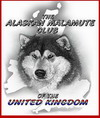 |
Coat Funk/Alopecia X |
Alopecia X, Black Skin Disease, Hair cycle Arrest, Follicular Dysplasia and Coat Funk are some of the names given to the hair cycle anomaly that affects plush double coated breeds.
Northern breeds including the Malamute are affected; others include Pomeranians, Chows, Samoyed, Keeshond but also the Miniature Poodle, not being plush or double coated.
Alopecia X is assumed to be an endocrine disorder. Previous studies have shown alopecic dogs have a slight increase in cortisol production. Cortisol is a steroid hormone which regulates a wide range of processes throughout the body including metabolism and the immune response. It also has a very important role in helping the body respond to stress.
Symptoms include abnormal shedding, leading to old hair not being replenished and giving the coat a dry texture and dull appearance. Hair colour fades giving a red tinge to the hairs. Guard hairs become dry and brittle leading to breakage, mostly noticed around the neck, exaggerated due to collar friction, the tail and breeches. Eventually the whole coat apart from head and legs is affected, leaving the undercoat having a sheep-like appearance. Sometimes bald patches can appear on the tail gland, neck, rear haunches and body in varying degrees in which the skin turns from normal colour to black (hyper-pigmented). The condition is said to be more prevalent in dogs than bitches and usually displayed before the age of 5.
| Young dog before being affected | Same dog at age 5, fully affected |
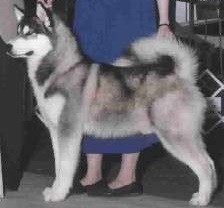 |
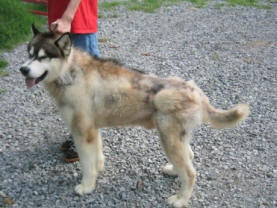 |
Blood chemistry, a FULL thyroid panel and Cushings Syndrome tests should be carried out to rule out other conditions; especially the last two as they present very similar symptoms which once medicated correctly will result in new coat growth. Further diagnosis by skin biopsy taken under anaesthetic can be offered but as the condition is irreversible and cosmetic, this procedure seems questionable.
Some success has been recorded with the use of Melatonin in either tablet form or implant. Neutering can promote new hair growth in 50% of affected dogs but this may not be permanent lasting only one growth cycle in some cases. Encouraging results have been shown with Trilostane, a Cushings treatment and studies have been conducted in the UK, USA and other countries on Pomeranians, Keeshonds, Malamutes and Miniature Poodles where Trilostane is thought to be a relatively safe option when monitored. Dogs diagnosed with Coat Funk did regain a normal coat in 80% of test cases. Treatment of two Pomeranian brothers with Black skin disease by micro-needling also showed good results and funnily enough dogs which have had biopsies do grow back hair at the biopsy point, the disruption of the follicles by this procedure and micro-needling obviously jumpstarts the growth cycle. Low level laser therapy has had encouraging results too.
| Micro Needling | Hair re-growth on biopsy points |
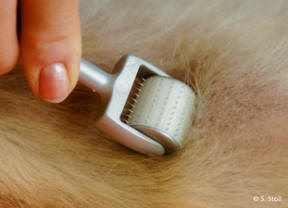 |
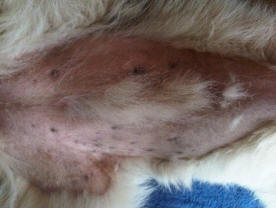 |
Coat funk is thought to be a hereditary condition. Unfortunately no research has confirmed any mode of inheritance and it is advised not to breed from affected dogs. A controversial suggestion regarding affected lines is to wait until dogs are over 5 years of age before breeding.